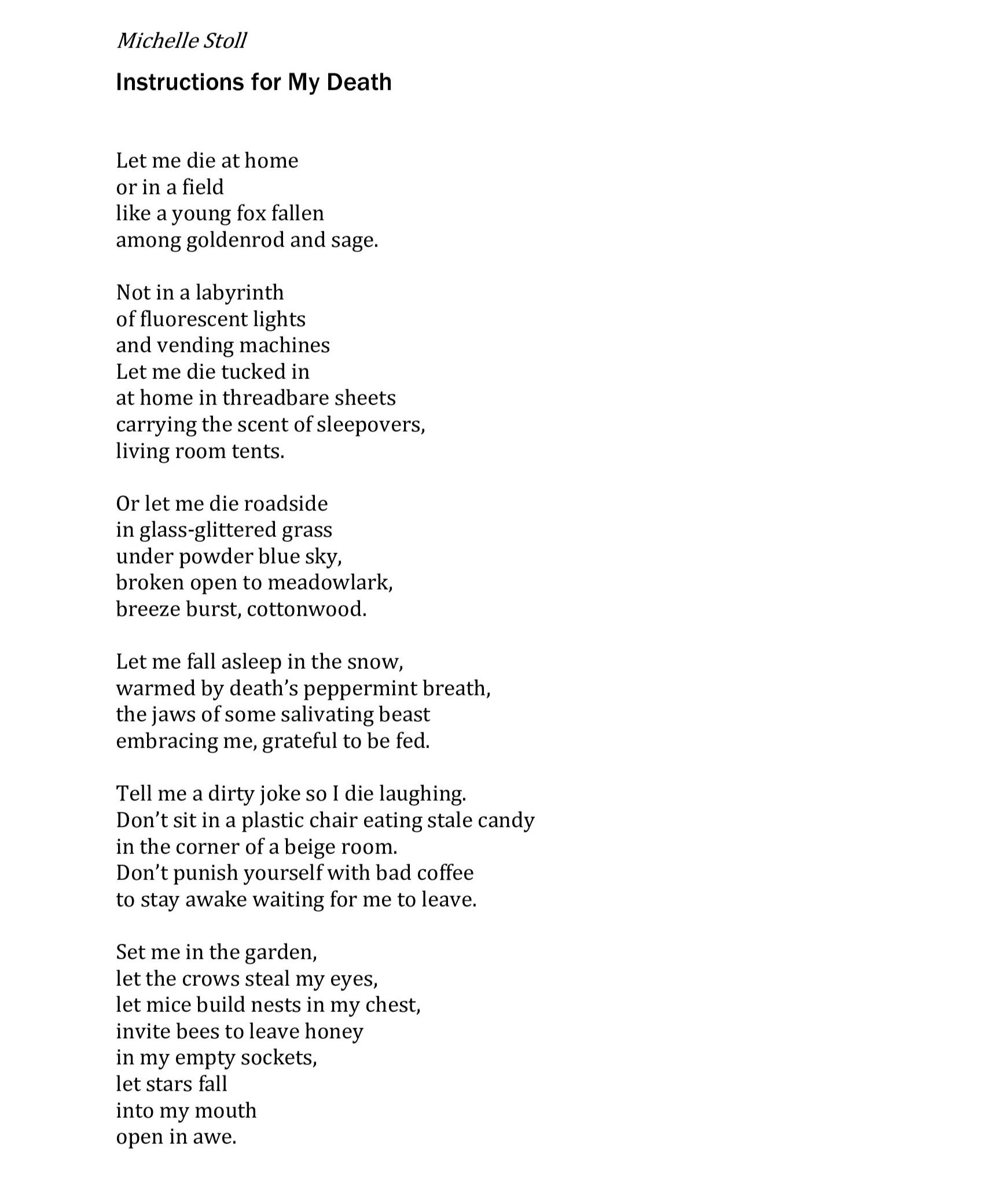Michelle Stoll lives in North Little Rock, Arkansas, and is an MFA candidate in the Low Residency Creative Writing program at Mississippi University for Women. Her poems have appeared in SLANT, Crosswinds Poetry Journal, The Galway Review, Glasgow Review, RockPaperPoem, among others. She was shortlisted for the Wigtown Poetry Prize.
Judge Thomas McGuire’s Commentary on “Instructions for My Death”
Instructions for My Death
It feels so natural, so right to think of Michelle Stoll as a poet-philosopher in the vein of Thoreau or Basho or Marilynne Robinson—like the best mortality mediations from these towering figures, her poem, “Instruction for My Death,” unmasks our greatest anxieties about death and dying by reminding us that the antidote to fear and trembling is not to turn away from our mortality in denial and disgust, nor is it to squirrel away the dying in “labyrinth[s] / of fluorescent lights / and vending machines,” but rather to craft humorous and clear-eyed meditations on death in the form of six, hard-driving stanzas that serve as an instruction manual on mortality. “Tell me a dirty joke so I die laughing,” writes Stoll. Smiling, refusing the temptation of passive suffering, singing all the way to grave—that’s the tenor of poet-philosopher Michelle Stoll’s invaluably, invariably wise instruction, the stuff of her philosophy on how to live well and die happy.
I love so many things about “Instructions for My Death”—its drop-dead gorgeous lyricism, its gentle chiding about how foolish and inauthentic it is to unhitch human death from the fabric of nature, the way it resists easy abstractions about mortality, and rather grounds its argument in sensual imagery. Stoll’s concrete poetic is at once tender and defamiliarizing: “Let me die tucked at / home in threadbare sheets / carrying the scent of sleepovers, / living room tents.” For all its sage counsel, all its clear-eyed good sense, perhaps the most delicious bit of advice comes at poem’s end — “Set me in the garden, / let the crows steal my eyes, / let mice build nests in my chest, / invite bees to leave honey / in my empty sockets, / let stars fall / into my mouth / open in awe.”
If philosophy begins and ends in wonder, this breathtaking image clinches my argument for Stoll’s status as a poet-philosopher. I’m awestruck by yokings like the “nest/chest” pairing above. Awe-struck, too, by how knowingly, effortlessly Stoll navigates the pleasures and pitfalls of the pastoral tradition. “Let me die at home,” declares the speaker, “or in a in a field / like a young fox fallen / among goldenrod and sage.” This poem thus does important field work in the realm of death and dying, interrogating not only the wrong-headed notions our culture has about what it means to die happy, but also interrogating some of the more naïve posturing of the pastoral mode. It might be tempting to see “Instructions for My Death” aligning neatly with a pastoral elegy like Brooke’s “The Soldier,” which elides the existential horror of violent, painful death by embracing a fantasy of beautiful death devoid of pain. But Stoll’s version of pastoral is different.
Refusing to settle for easy consolations offered by prettified visions of death, Stoll doesn’t fall for the lie of what’s been called soft pastoral, a kind of green thoughts in a green land, starry-eyed bliss that refuses to recognize the degree and kind of lethal damage the Machine in the Garden can do. Stoll’s pairings of death and beauty forge a refreshing brand of rough-hewn, hard pastoral. “Or let me die roadside,” intones the speaker, “in glass-glittered grass / under powder blue sky, / broken open to meadowlark, / breeze burst, cottonwood.” Here Stoll’s sound sequence embodies terrible beauty at its best—a tidal wave of violent plosives (t’s, b’s, k’s) combines with sibilance suggestive of a shattered windshield. Countering this rough-grating sonic realism is also the soothing, mournful wail of repeating o’s and w’s.
This kind of clear-eyed realism married to the music of mimesis confirms my impulse to call Stoll a poet-philosopher. It was Montaigne after all who said of Cicero’s meditations, “To philosophize is to learn die.” And it was Cicero who quipped, “He who has learned how to die has unlearned how to be a slave.” I count Stoll in the company of these thinkers because her honest vision of death bears the wisdom of a naturalist. By taking death back from the medical industrial complex and helping us see how it’s best approached—i.e., naturally, authentically--she helps release us from the thrall of fear and trembling. Let’s hope Stoll returns again and again to the subject of human mortality. She’s so good on death and dying, we’d do well to keep reading her all the way to the grave.



